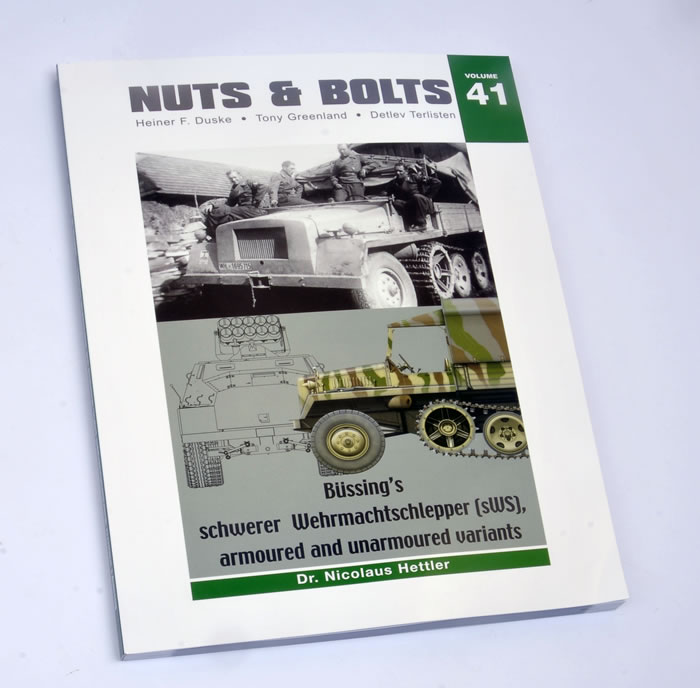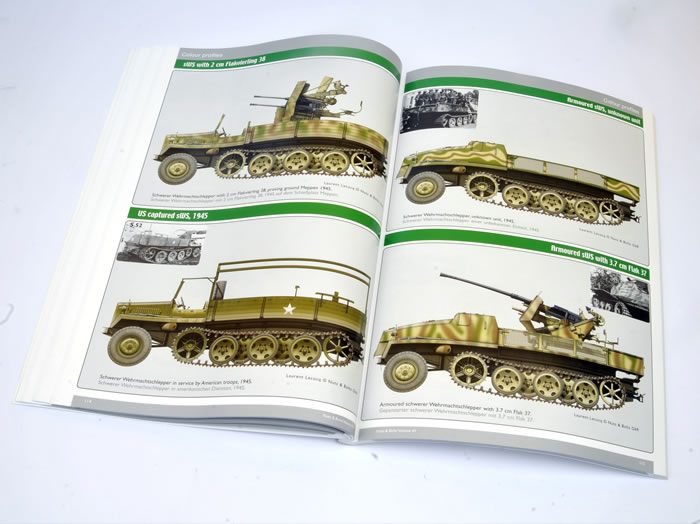|
|
|
|
| Home > Reviews > German > Nuts & Bolts Vol. 41 -Bussings Schwerer Wehrmachtschlepper (SWS) Armoured and Unarmoured Variants |
Nuts & Bolts Vol. 41
Bussings Schwerer Wehrmachtschlepper (SWS)
Armoured and Unarmoured Variants
Reviewed by Luke Pitt

Summary
| Title and Publisher: | Nuts and Bolts Volume 39 |
| ISBN: | Not quoted |
| Media and Contents: | Soft cover; German and English text; 224 pages; 430 photos (272 contenmporary photos from manuals, 120 colour photos, 38 models) 14 camouflage schemes, tactical markings, table of organsisation (KStN) |
| Price: | Euro 29.90 available online from Nuts & Bolts' website |
| Review Type: | FirstRead |
| Advantages: | An excellent publication that strikes the right balance between historical fact, photo coverage and high quality colour profiles. |
| Disadvantages: | |
| Recommendation: | Highly Recommended |
FirstRead
The German SWS class of halftrack was the pinnacle of German halftrack design. The battlefield had changed however, and moves had already been put in place to have towing and other duties migrated to fully tracked vehicles. From a design point of view, the halftrack concept was a technical dead end.
The “Nuts and Bolts” series of reference titles really need no introduction. What they offer is a one-stop reference source for the particular vehicle they cover. I like the convenience of these books. For me, it’s is so much easier to just grab them, open a page when required and basically getting on with it. In reality, these books are more like five traditional books in one, a development history, wartime photo coverage, line drawings and colour profiles and a comprehensive walk around photo essay.

This new reference work has some 189 pages. This reference work is logically broken down into segmented parts. The first 36 pages are devoted to the development and history of the SWS in concept, prototype and in service. Within this section, selected subsections discuss the development and technical description, followed by the differences between the prototype and production vehicles. The book is jammed packed with details like the variations of the weapon system itself and how they were used in the field. I particularly liked the way the authors have detailed each division that operated these vehicles and in what time frame. 26 black and white phots and drawings are in included. The second section from pages 37 to 40 cover all the avaliable kits avaliable. The third section is lavishly illustrated with a little over 75 black and white war time photos. The clarity and captions on these photos are noteworthy as they cover an infinite number of additions and modifications adopted in the field.
The next 36 pages are devoted to 1:35 scale plans of all the known versions. The illustrations and three-dimensional drawings by Lieuen Coninck are wonderfully done. Twenty-two colour profile drawings follow, over the next 11 pages and are wonderfully executed and presented. What I like about these profiles is that within the profile itself, a small black and white photo is inserted to which the artist has given his interpretation. This, I believe should be the industry standard. The next 46 pages consist of 121 colour walk around photos of restored examples. The entire vehicle is covered from the interior; engine through to a detailed study of how all the various hatches opened. The last 6 pages are devoted to three model builds by Tony Greenland and Vinnie Branigan.
In summary, if you plan to build this particular vehicle then, you really can’t go past this book, it’s has everything you could possible need reference wise, with lashings of inspiration as well.
Thanks to Nuts & Bolts for the sample
Nuts and Bolts publications are available online from their website.







